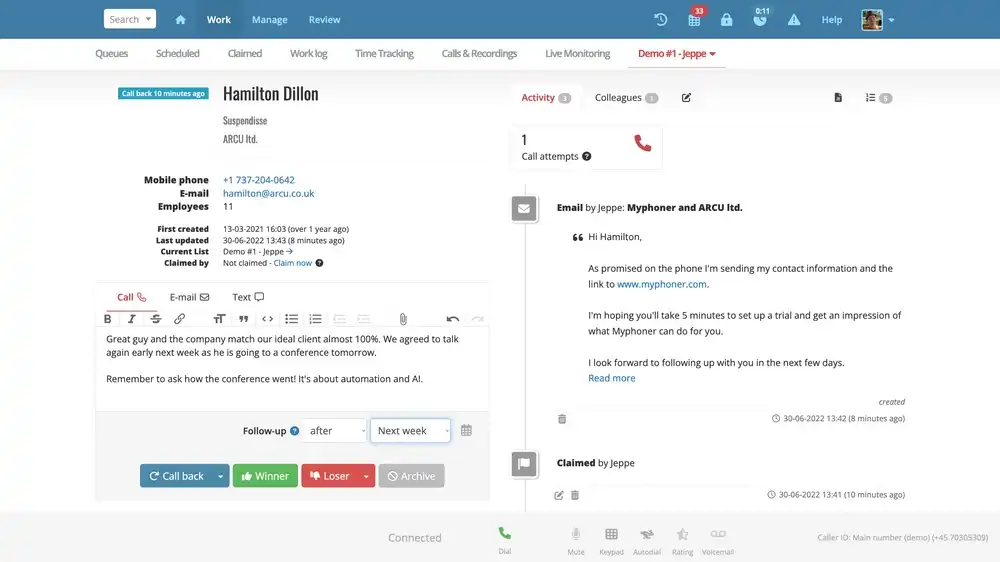Cold-Calling Questions to Ask to Boost Conversions

- September 3, 2022
For B2B, cold calling is an effective way to gain a competitive edge and grow your business. However, most salespeople don’t succeed at it.
Why?
They don’t do proper research and create lacklustre pitches that aren’t engaging. As a result, 72% of their cold calls get rejected.
But with open-ended strategic questions, you can lead prospects into buying your product quicker.
Questions make them open up about their needs. This way, you get an edge to drive your product as a solution to their problems. In addition, questions help you gather more details that will aid you in future follow-up interactions.
At Myphoner, we’ll introduce you to 20 open-ended questions to add to your outbound call script.
We’ll cover the perfect way to use them on your calls, and explore some best practices for successful B2B cold calling.
Let’s go!
Must-Know B2B Cold Calling Tips
The key to being successful at cold calling is not making more calls. It’s about reaching out to the most qualified prospects.
Very often, salespeople spend time crafting the perfect pitch and presenting a call well only to be met with this common phrase:
“Thanks for your pitch, but I’ll have to present this to the guy who makes decisions here.”
And that’s one of the reasons that many salespeople get wrong. So if you want to have more success in your sales calls, here are more tips to help you save time and generate more leads:
Quick pause to highlight Myphoner. Don't worry, your article resumes below.
Selling to undefined over the phone?
Use our sales dialer to call customers and prospects in undefined at the most competitive rates

Define your target business
Avoid the thought that making many calls will get you a higher chance of getting a client. You will be better placed to get a lead once you’ve researched possible clients and narrowed your list to suitable matches.
Research your targets
Once you have settled on suitable matches, do some more research. Find out who the decision-makers are. This may mean making fewer calls but getting a higher success rate.
Also, check out the prospect’s social media profiles like LinkedIn, Twitter and Google. You’ll learn about the technologies they use and the challenges they may be facing.
This background check is essential because 62% of buyers are more likely to buy a product that solves a current problem they’re facing. You can start by trying to understand your prospect’s company and business needs.
Finding out your prospect’s background, the company’s industry ranking, industry trends, executive decision makers, competitors and customer base can go a long way towards asking the right cold calling questions.
Understand your product deeply
Every successful salesperson has one thing in common - they’ve mastered every nitty-gritty detail about their product.
Doing so will help you prepare for impromptu questions a potential buyer asks when they want to escape your grip.
You don't want to find yourself mumbling answers or asking to get back to them. You can't expect a prospect to trust you when you don't even know what you are selling.
Avoid filler questions
When you kick off the conversation, try to avoid filler questions. Not only are they irritating to the prospect, but they don’t advance your call towards a purchase. Leave behind questions such as “Is now a good time?” and “I wanted to touch base about…”
In fact, asking “Is now a good time?” on a cold call can reduce your likelihood of booking a meeting by up to 40% - ouch!
Instead use powerful, clear sentences about why you’re calling and ask the right cold calling questions specific to your prospect’s business.
Get your prospect to engage
Your prospects are busy people with a lot going on every day. It’s vital that you engage them with something interesting that either builds your relationship or furthers the buyer journey.
For example, mentioning their Alma Mater, business, industry news, etc. could hook your prospect and lead to better cold call questions.
Ask relevant discovery questions
To hack this, ensure you plan your discovery questions depending on the information you found from your research.
Discovery questions are those that give you more information about your specific prospect’s company, role, goals, priorities, etc. Often they start with “tell me about…”
Discovery questions can feel a bit like interviewing your prospect, but they shouldn’t be overwhelming. Try to adapt your discovery questions according to the information you find out and always tie them back to the customer journey.
Use the right cold calling tech
Top cold calling software like Myphoner can make a difference in having efficient cold calling experiences that lead to sales.
Cold calling can be a gruelling and time-consuming process. That’s why using a cold calling software platform that helps you focus and work faster so is essential.
The best cold calling software is easy-to-use and allows sales teams to set up lead routing that actually works.To ensure a great B2B cold calling experience, we recommend a platform that works with - like Myphoner.
Now that you have power technology behind you, what cold call questions should you ask?
Best Cold Call Opening Lines To Command Attention
Whilst your pitch and how you end the call is the crucial part of the call that seals the deal, it’s important to open well. How do you open a cold call?
Using bad opening lines will fail to capture the attention of your potential buyer, and you’re essentially ripping away your opportunity to sell your product.
Here are some of our picks for the best lines to open cold calls with.
1. Ask ‘How have you been?’
We know, this line sounds like filler - but trust us, in practice it works. Asking how your buyer is disrupts the pattern of a typical sales call and helps build a meaningful rapport with who you’re calling.
Buyers are likely to find this sort of question kind and compassionate and will immediately command a response. This will result in them dropping their guard somewhat. It also reinforces familiarity with the buyer - especially if you’ve spoken to them before and have a pre-existing relationship.
How effective is this approach? Gong found that using “How have you been?” as an opening line can improve your likelihood of scoring a meeting by 560%.
2. Briefly introduce yourself and state why you’re calling
Buyers are busy, and won’t bother to guess who you are or assume why you’re calling. A great (and obvious) tactic is to briefly introduce who you are and get straight to the point.
Here’s an example of how we’d do it:
“Good morning, Mr Crown, this is Maddie from Myphoner. I’m calling to ask whether you’d be interested in upgrading your cold calling and CRM platform to make you work faster.”
3. What if they’re not interested?
What do you do if your buyer responds with “Sorry, no I’m not interested”? We would recommend simply asking why: “I’m sorry to hear that. If you don’t mind me asking, why?”
Their next response is key. If their reservations are something you can address, this is where you can rescue their interest. Here’s an example exchange:
Buyer: “I’m already using a CRM that I’m happy with, thanks.”
Caller: “Can I ask, who’s your CRM provider?”
This is where your knowledge of your product comes in handy. Find a common pain point that customers of your competitor have and address it. For example:
Caller: “Ah, I see. We have many customers that were with that provider, and they say our platform can do everything your current provider can do but for a much lower monthly price”.
If your buyer says they still aren’t interested - well done, you’ve saved yourself from going through your whole pitch before finding that out. You may wish to end the call by giving your details (such as a website to check out) if they change their mind.
4. Mention a common connection or lead source
One of the main difficulties that cold callers face is not being able to establish credibility and trustworthiness. Buyers are naturally going to be sceptical and pessimistic about your pitch when calls are unsolicited.
That’s why cold callers need to anticipate these two important questions and incorporate the answers into their opening passage:
- How do you know me?/How did you get my number?
- Why should I trust you?
We can solve this issue by dropping in the name of a common connection, or even better, telling your buyer the person who referred you to them.
This makes your call far more credible as it signifies that people within the buyers’ circle trust your company and use your products.
Make sure this is a genuine connection, however. Mentioning someone the buyer doesn’t in fact know will dramatically damage your credibility and will make you look bad. That’s why researching your buyer before picking up the phone is so important.
5. Be polite and thank buyers for their time
This technique is a great way to close your opener. It’s great to include a humble thank you for their time. Something along the lines of:
“Thank you for taking the time out to speak to me. I really appreciate it.”
When done successfully, this can help dispel any annoyance the lead may have for being interrupted.
Use this technique carefully, however - as sounding too desperate or apologising too much can hurt your perception of confidence. Try to avoid saying:
- “Thanks for picking up the phone” - This implies you’ve been trying to call so many people without success.
- “Sorry for disturbing you”. It’s much better to thank them for their time, as apologising puts you on the back foot and is more likely to annoy your buyer. A particularly irritated lead may hit back with: “Why did you call then?”.
A simple ‘thank you’ portrays more confidence than an apology and may result in a more positive perception of you and your product. It’s both humble and direct!
6. Can you help with…
This is an interesting psychological trick that preys on our natural instinct to be helpful.
This so-called “urge to help” was popularized by development psychologist Michael Tomasello in his book “Why We Cooperate”. In it, Tomasello suggests that we’re born with an innate desire to be helpful to others.
Cold callers can use this principle to improve their chances of scoring a meeting with a lead. Try opening with:
- “Good morning, Ms Crown, I was wondering whether you could help me with…”
- “I’m looking for someone within your organization who would be interested in [product category]. Could you assist?”
- “Thanks for taking to the time to speak with me. Can you help me out for a minute?”
This makes your leads feel important and will reduce the chance of them hanging up on you.
Open-Ended Questions When You're Losing the Lead
A prospect may sound uninterested in your call, but you can't give up without putting up a fight. Well, not literally, but try to keep a prospect interested without sounding desperate.
Why use open-ended questions for sales?
Open-ended questions for sales are those that don’t have one clear answer. Often they give you new information and take you down unexpected paths. You’ll want to use open-ended questions for sales to discover your prospect’s needs and priorities.
As you learn new information, you’ll be able to switch gears and guide your prospect towards a purchase. Getting this information is vital to understanding how to present your product to your prospect and gain traction with him/her.
Overall, open-ended questions for sales help you gather information, understand your prospect’s needs, make your prospect feel heard and advance your pitch towards a purchase.
Here are some of the top open-ended questions for sales to get results during your next cold calling experience:
7. Try to find out if they may need your product in the future
You can ask a straight-up question like, "When do you suppose your company will need this type of product/service?"
If the prospect mentions they may consider it in the future, you can mark that for future follow-up. You can also ask indirect cold calling questions about your prospect’s business priorities, challenges, problems, budget and current suppliers. For example, a question such as “What challenges do you face when solving your business problems?” is a great way to find out what your prospect has tried before.
8. Offer to demonstrate your product
In most cases, you’ll find out that your prospects haven't heard about your product. So they probably don't know how it works.
A demonstration will show your product in action. This helps your prospects understand better its value or how it can solve their problem.
Here’s a typical question you’ll ask.
"Would you be interested in a demo meeting to see how this can help you?"
9. Ask why they don't want the product you are offering
If you realize that you are losing the lead, make a point to know why the prospect is objecting to your offer.
You can ask something like, "Do you mind letting me know if there is any reason for us not to move forward with this discussion?"
Note that the question isn’t pushy. Keep it casual and respectful, which can bring the prospect back on track.Another strategy for understanding “no” is to ask cold calling questions about their ideal solution, such as “What kinds of terms would you like to establish?”
Probe into what criteria and features this ideal solution would have, as well as their must-haves for working with a new supplier. This can help get new information and highlight any product features that align with your prospect’s vision of success.
10. Find out if there is someone else you can talk to
You should ask this question when you notice you’re talking to the wrong person. Of course, a little bit more research could avoid getting here.
But in case it does, you don’t want to give your all in a call that might end up in the rubbish bin. The question is intended to help you connect with a decision-maker or other stakeholders involved in critical purchases. These can be project managers, procurement managers, or even the CEO.
Here are a few cold calling questions to ask: "Who else should we involve in this call?", “Who else will influence this decision?” and “What other people or factors will impact your buyer decision?”
Ideally, you can use power dialer software like Myphoner’s to call these new leads and set up follow-ups as needed.
Questions to Ask to Restart a Cold Calling Conversation
Cold calling intends to gather as much information as you can about your prospect. However, some prospects may not be willing to give the information.
Luckily, if the person has not hung up on you yet, you still have a chance to turn the call to your advantage.
11. Share an insight
If you had done your research well about the particular business and their industry, you could use some valuable information.
Share an insight that relates to their business and has a connection with what you are offering.
This may arouse their interest, especially if it's something they are not aware of. A question such as " I'm sure you know but it might be worth mentioning that A% of companies in your industry using our product generate 20% more revenue?”
12. Mention a common problem that you want to solve
You already know from your research that your target customer has a special need, but you don't want to sound like a desperate salesperson.
Mentioning a pain point may make them give you the information you want. For example,
"Our customers report experiencing such and such problem, have you experienced something similar?”
13. Ask about their current product
Selling for B2B customers today is hard. Times have changed, and the salesperson isn’t in charge of the buying process anymore.
Buyers do their research when they want to buy a product. Now, this question is meant to shift the buyer from a product they already use to yours.
The idea here is to help you get more information about what your competitors are offering. And how to leverage their weaknesses to strengthen your pitch.
Ask what they like the most about their current system. Is there anything they dislike? If they had a chance, would they want to change the product? Is the product they’re using working for them?
14. Bring up something happening in the industry
The B2B space is very sporadic. Selling to B2B customers is not as easy as selling to B2C customers.
But you can use this knowledge to get your prospects' attention, more so if it’s a developing issue.
Here’s an example of a question you can ask.
"A, B and C are going on in your industry. Has this affected your business?"
15. Ask a series of discovery questions to ensure you'll get a follow-up call
An opportunity to follow up means your prospect is interested in your product. He simply needs a few more nudges to close the deal.
The more you can learn about your prospect, the more likely you can build a better relationship. Use discovery questions “tell me about… your role, current challenges, budget priorities, etc.” to cinch that follow-up call.
You can even schedule a follow-up call to talk more about your prospect’s challenges. Statistics show that 60% of prospects will say no four times before agreeing to make a purchase. The key is persistence.
16. Build rapport with your caller
Even if you don’t make progress with selling your product, try to build a good relationship with your prospects. You never know when their business needs will change, or your pitch will finally hits home.
You can ask open-ended questions for sales that help build rapport. When it feels right, ask more personal questions to get to know your prospect and keep them talking with you.
17. Get their feedback on your product
Not every cold calling experience will lead to a purchase right away. Before the call ends, find out what’s stopping your prospect from liking your product. You can do this directly by asking “Why doesn’t this product resolve your problem?” or “What about this product isn’t working for your needs?”
These direct feedback cold call questions can help you get information about your prospect’s pain points and preferences when it comes to solutions.
18. Find out if they want more information about your product
A prospect may not remember much of what you are offering after your cold call. It would be good to send over more information.
You’d send over a question like this: "Is it alright if I send over some more information through email? And is there any particular info you'd want to be included in the email?"
19. Seek to know if they plan to make a future purchase
If you notice that the call is winding down, it’s time to ask that key sales call question:"What's your timeline for making a purchase decision?"
Remember that just because your prospect isn’t buying today doesn’t mean that he/she won’t at all. By finding out a timeline for this decision, you can better follow-up and tailor your messaging within the next few days or weeks.
20. Ask to call another time if the timing isn’t appropriate
You may make a call when the prospect doesn't have the time to have a discussion. Use the chance to ask what time would be best to call to share what you were offering. A cold calling question such as “When can I call back to continue our discussion?” can do wonders.
In addition, a pro tip for scheduling a follow-up is to send the invite before you hang up. You can use cold calling software like Myphoner to quickly schedule a follow-up. Quickly send over the calendar invite via email and ask if he/she sees the invite while on the call. This way you can be sure that your follow-up call is scheduled at a good time for your prospect.
Example of a successful cold call
To get results during your next call, you can use this cold calling example below. As we’ve discussed, it’s important to use a positive tone and personalize your call as much as possible according to your initial research. Use this example of a cold call to fill in your own information:
“Hi [PROSPECT NAME], this is [YOUR NAME] from [YOUR COMPANY]. Congratulations on your recent success with [INVESTMENT/CAMPAIGN/AWARD]! I’m so impressed by what you’re doing at [PROSPECT COMPANY].
I’m calling because I think we can help you take your [INDUSTRY/CAMPAIGN/OFFERING] to the next level. In a nutshell, what we do at [YOUR COMPANY] is help [YOUR PRODUCT’S IMPACT].
Is this something that interests you? If so, I would love to run through our product’s main features with you.”
You can personalize this cold calling example according to your product’s main impact for your prospect’s business. In particular, be sure to match your product’s appeal to your prospect’s pain points in order to get a positive response.
Conclusion
Cold calling can be a huge success if you incorporate it into your sales strategy. You only need to carry out thorough research, ask the right questions and rely on best-in-class cold calling software like Myphoner. Remember, you only have one chance to make an impression, so make sure you’ve got all the tools you need to succeed.

Written by
Carlos Chersia
I'm Carlos! Account manager here at Myphoner. I love exploring new ways of making systems and people work together.
At Myphoner, I do exactly that. Understanding how our clients think and what processes they come from, helps me help them utilize Myphoner to the maximum, providing value for the clients, and better understanding for the rest of my Team.
Related articles

Industry Related
9 SMS Use Cases for B2B Sales
SMS messaging has better traction than most other forms of outreach, is affordable to use & increases sales. Learn how to use it as part of your sales strategy.
October 2, 2022

Tools & Practices
6 Cold Calling Tools & Software for Everyday Use
Cold calling is a major part of prospecting. Successful sales teams are constantly reviewing new tools to help them find success. Here's our current favourites.
September 19, 2022

Industry Related
8 Techniques On How To Better Handle Your Next Inbound Sales Calls
We take you through different ways to handle inbound sales calls effectively, giving you further confidence to close the deal.
August 18, 2022